Sixty-five years ago
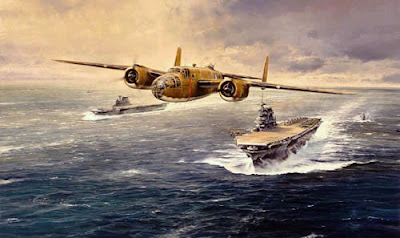
Guts, determination, innovation – courage were defined
(and well before Joint was “cool”)
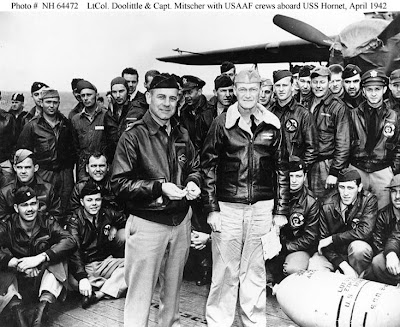
Conceived in the dark aftermath of the attack on Pearl Harbor, the raid had its genesis in the idea of CAPT Frank Lowe, USN who predicted that Army twin-engine bombers could be launched form a carrier under the right conditions. Planned by Lieutenant Colonel Jimmy Doolittle, USA and executed by 16 modified B-25B’s of the 34th BS, 17th BG flying from the deck of the USS Hornet (CV 8) – 650 nm from Tokyo, history was made and an enemy left shocked. The raid took place after only two months of planning and special training with 16 all volunteer crews. More on the raid itself
here,
here and
here.
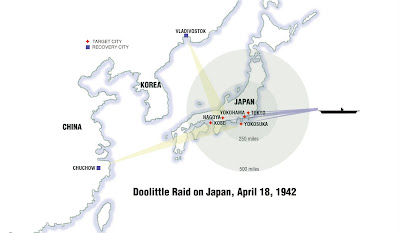

North American B-25B Mitchell
The B-25 stemmed from an Army Air Corps competition that was won by Martin with their B-26 design. The contest was a novel one in that the Army would order the winning design straight into production, by-passing the prototype phase. Despite having garnered almost double North American’s score, Martin was adamant that they were not going to be able to produce the B-26 in the numbers the Army Air Corps wanted – so they awarded North American with the remainder of the contract. The B-26 was fast, rugged and could carry a significant bomb load – outstripping he B-25 in each category. It’s airframe was designed and constructed such that the ability to take punishment was legendary and second only to the B-17. Yet because of its high wing loading, the B-26 was also notable for its fast landing speeds and long takeoff requirements. The B-25, on the other hand, reached production sooner, also demonstrated a capable bomb carriage capability and, for the purposes of this mission, had take-off requirements that suited it for the carrier.
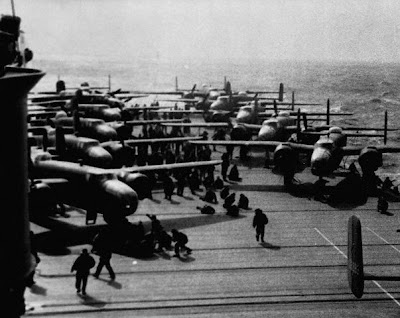 Still, when all was said and done, these were (relatively speaking) big aricraft on a small flight deck. Carriers wouldn’t see the likes of this until after the war with the advent of the specially modified P2Vs for the nuclear mission – and then those were limited to the much larger decks of the Midway-class carrier.
Still, when all was said and done, these were (relatively speaking) big aricraft on a small flight deck. Carriers wouldn’t see the likes of this until after the war with the advent of the specially modified P2Vs for the nuclear mission – and then those were limited to the much larger decks of the Midway-class carrier.

TECHNICAL NOTES:
Armament: Six .50-cal. machine guns; 3,000 lbs. of bombs
Engine: Two Wright R-2600s of 1,700 hp each
Maximum speed: 328 mph
Cruising speed: 233 mph
Range: 2,500 miles (with auxiliary tanks)
Ceiling: 21,200 ft.
Span: 67 ft. 6 in.
Length: 53 ft.
Height: 16 ft. 9 in.
Weight: 29,300 lbs. maximum
Cost: $109,670 (1943)
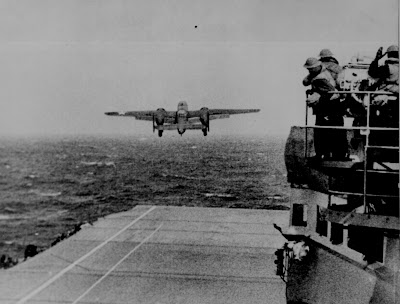 Post Script:
Post Script:
Some few years ago (OK, 23 years) I was standing in line at a bank in the main building of the Naval Postgrad School in Monterey, quite engrossed in some transaction I had to make. Standing in front of me was a elderly gentleman who also was quietly waiting his turn at the busy counter. As he approached, the teller exclaimed with considerable joy and surprise “Why General Doolittle! What a pleasure to see you sir – we see so little of you lately it seems!” Needless to say, I jerked my head up so fast I swear I’d broke my neck. Still, it’s not every day you got to meet a living legend and a very gracious and humble one at that…
– SJS
 Conceived in the dark aftermath of the attack on Pearl Harbor, the raid had its genesis in the idea of CAPT Frank Lowe, USN who predicted that Army twin-engine bombers could be launched form a carrier under the right conditions. Planned by Lieutenant Colonel Jimmy Doolittle, USA and executed by 16 modified B-25B’s of the 34th BS, 17th BG flying from the deck of the USS Hornet (CV 8) – 650 nm from Tokyo, history was made and an enemy left shocked. The raid took place after only two months of planning and special training with 16 all volunteer crews. More on the raid itself here, here and here.
Conceived in the dark aftermath of the attack on Pearl Harbor, the raid had its genesis in the idea of CAPT Frank Lowe, USN who predicted that Army twin-engine bombers could be launched form a carrier under the right conditions. Planned by Lieutenant Colonel Jimmy Doolittle, USA and executed by 16 modified B-25B’s of the 34th BS, 17th BG flying from the deck of the USS Hornet (CV 8) – 650 nm from Tokyo, history was made and an enemy left shocked. The raid took place after only two months of planning and special training with 16 all volunteer crews. More on the raid itself here, here and here.
 Still, when all was said and done, these were (relatively speaking) big aricraft on a small flight deck. Carriers wouldn’t see the likes of this until after the war with the advent of the specially modified P2Vs for the nuclear mission – and then those were limited to the much larger decks of the Midway-class carrier.
Still, when all was said and done, these were (relatively speaking) big aricraft on a small flight deck. Carriers wouldn’t see the likes of this until after the war with the advent of the specially modified P2Vs for the nuclear mission – and then those were limited to the much larger decks of the Midway-class carrier.





2 Comments
Comments are closed.